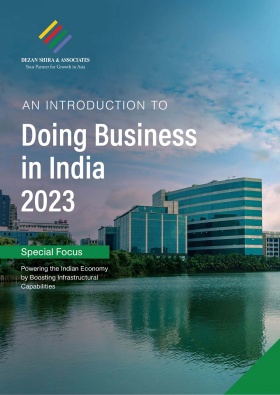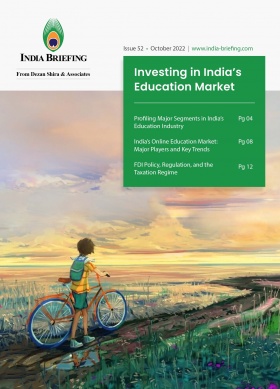India-Canada FTA Negotiations: Interim Deal Expected this Year
UPDATE: Canada halted progress on the proposed free trade agreement with India on September 1, only three months after both countries expressed their intention to finalize an initial agreement within the year.
India and Canada are keen on settling terms to a free trade pact by the second half of 2023. Key stakeholders to the process have indicated to the media that negotiations are “progressing fast”.
The two countries have drawn the roadmap for a two-step free trade arrangement. The first, an interim deal, will be called the Early Progress Trade Agreement (EPTA), and may cover new areas. Discussions are under way to include new subjects like labor, environment, trade and gender, and small and medium enterprises (SMEs), besides traditional areas like goods, services, and investments. While India is confident on negotiating the new subjects, it is being cautious about raising non-tariff barriers.
In this article, we discuss the negotiations to the upcoming India-Canada EPTA, growth in bilateral trade and investment relations, and scope for commercial partnerships in the respective markets.
Bilateral trade and FTA negotiations
India and Canada recently held their sixth Ministerial Dialogue on Trade and Investment (MDTI) on May 8, 2023. These dialogues are meant to explore the bilateral commercial relationship.
In recent discussions, the potential for signing an EPTA has emerged, to be followed by a Comprehensive Economic Partnership Agreement (CEPA). Key goals overall include promoting bilateral investment and cooperation, green transition, and business-to-business (B2B) engagement.
This trade treaty strategy is similar to India’s efforts with Australia. The India-Australia Economic Cooperation and Trade Agreement (ECTA) came into effect end of 2022 following accelerated negotiations. The next step is to conclude a full-fledged FTA – the India-Australia CEPA.
Further, seven rounds of India-Canada EPTA discussions have taken place as of April 2023. According to trade and commerce department officials, the services sector has played a significant role in advancing the India-Canada bilateral relationship. Discussions have avoided sensitive areas. Pending subjects include investment and trade remedies.
The tracks covered in the seventh round of negotiations in April include goods (tariff), sanitary and phytosanitary (SPS), technical barriers to trade (TBT), rules of origin and origin procedures, customs and trade facilitation, environment, labor, trade in services (telecom/ financial services/ professional services/ temporary entry of workers, dispute settlement, institutional and core provisions. – Official speaking to Indian media
A potential CEPA between Canada and India is expected to greatly enhance bilateral trade. Projections indicate that it could lead to a substantial increase in bilateral trade, estimated at US$8.1-11.88 billion, and result in significant GDP gains of US$6.885-10.8 billion for Canada by 2035. Furthermore, Canadian exports from sectors like fruits and vegetables, chemicals, wood products, and minerals would experience significant growth because of this proposed free trade agreement (FTA).
|
India-Canada Bilateral Trade |
|
|
Canada’s key imports from India |
India’s key imports from Canada |
|
|
In 2022, India ranked as Canada’s ninth largest trading partner and a priority market. It was a noteworthy year for trade relations between the two countries, with bilateral trade in goods reaching an impressive value of approximately US$8.2 billion. This represents a remarkable growth rate of around 25 percent compared to the trade volume of 2021.
In FY 2022-23 (April 2022 to January 2023), bilateral trade in goods reached US$6.9 billion, with Indian exports amounting to US$3.48 billion. Canadian exports to India amounted to US$3.42 billon, during this period.
|
India-Canada Bilateral Trade in Goods (CAD Million) |
|||||
|
|
2018 |
2019 |
2020 |
2021 |
2022 |
|
India’s exports to Canada |
5075 |
5282 |
4971 |
6033 |
8332 |
|
India’s imports from Canada |
4294 |
4841 |
3713 |
2994 |
5341 |
Source: India Canada Economic Engagement Report, CII
|
India-Canada Bilateral Trade in Services (CAD Million) |
|||||
|
|
2018 |
2019 |
2020 |
2021 |
2022 |
|
India’s exports to Canada |
2178 |
2743 |
2471 |
2431 |
2903 |
|
India’s imports from Canada |
3725 |
5271 |
4853 |
4905 |
6020 |
Source: India Canada Economic Engagement Report, CII
Bilateral investments
Alongside the EPTA, India and Canada are also negotiating a Foreign Investment Promotion and Protection Agreement (FIPA).
As of December 2022, Canada ranks as the 18th largest foreign investor in India, having made cumulative investments amounting to US$3.184 million since April 2000. Canadian investments constitute approximately 0.5 percent of the total foreign direct investment (FDI) inflow into India.
Canadian investment in India
More than 600 Canadian companies currently operate in India, contributing significantly to job creation, innovation, and technology transfer. Some leading examples include Sun Life Financial Inc., McCain Foods, Magna International Inc., IBI Group, etc.
Canadian capital via private equity (PE), pension funds, and FDI has been directed across diverse areas, such as real estate, renewable energy, telecommunications, information technology, manufacturing, infrastructure, agriculture, banks, non-banking financial companies (NBFCs), and start-ups. About 40.63 percent of total Canadian FDI into India, however, is concentrated in the services and infrastructure sectors per a recent estimate.
Notable Canadian investments in India include ventures in the telecom sector, such as Brookfield Asset Management’s investment in Reliance’s JIO, as well as CPDQ’s investment in the automotive sector with Mahindra and Mahindra. In Q3 2023, the Canada Pension Plan Investment Board (CPPIB) backed wealth and asset management firm, IIFL Wealth, with an investment of US$53 million for a 2.7 percent stake. It also committed to US$205 million in investments into IndoSpace Logistics Park IV, a real estate vehicle managed by India-based real estate company IndoSpace. In 2019, the CPPIB made a strategic investment of US$115 million in Delhivery Pvt Ltd., acquiring an eight percent stake in the company. This investment expanded CPPIB’s presence in India’s logistics sector. Delhivery, a relatively new player in the Indian market, has experienced significant growth due to the rapid expansion of e-commerce in the country.
Other such Canadian stakeholders in the Indian private sector include the British Columbia Investment Management Corporation, Fairfax Financial Holdings Limited, the Ontario Municipal Employees Retirement System (OMERS), and the Ontario Teachers’ Pension Plan (OTPPB).
Indian investment in Canada
Indian companies have made substantial investments in Canada, particularly in the manufacturing and engineering, ICT and telecommunications, life sciences, pharmaceuticals, and healthcare, financial services, energy, and food and retail sectors.
Prominent Indian conglomerates, including Aditya Birla and Reliance, have established a strong presence in Canada, with their cumulative investments near about US$5 billion. Notable Indian IT-enabled services (ITeS) firms providing consultancy services in Canada include industry leaders TCS, Wipro, and Infosys.
A May 2023 report launched by the Confederation of Indian Industry (CII), ‘From India to Canada: Economic Impact and Engagement’, indicates that 30 Indian companies employ around 17,000 full-time and part-time hires in Canada. Total Indian investments exceeded CAD 6.6 billion (US$4.89 billion), with a presence in eight out of 10 Canadian provinces. Total Indian expenditure in R&D in Canada amounted to CAD 700 million (US$518.64 million).
Indian diaspora in Canada
Canada has one of the largest numbers of skilled Indian immigrants, who bring with them knowledge and expertise in various sectors, thus facilitating trade investment, cross-border networks, and market expansion. India is also the largest contributor of international students in Canada, which contributes to the economy by fulfilling the existing shortage of manpower in various sectors like IT, professional services, etc.
Indians studying in Canada
Canada is the second most popular destination for Indian students pursuing academic degrees abroad. Canada processed over 360,000 study permit applications from Indian students last year, 55 percent more than in 2021.
Per media reporting, 226,450 Indian students went to study in Canada in 2022. In fact, after India, the next two leading sources of international students to Canada were China at 52,165 and the Philippines at 23,380. India is also in the top 10 source countries for international students already enrolled in Canada at 319,130 (as of December 31, 2022).
The international student community annually contributes more US$15.3 billion to the Canadian economy.
As the Indian education sector itself undergoes a transformation under the National Education Policy, NEP, 2020, a multitude of opportunities are available for Canadian investment and R&D partnerships across school and higher education levels, digital learning, and professional training segments. India is now open to foreign educational institutions establishing branch campuses in the country.
Maximizing mutual benefits and collaboration via trade and investment
India and Canada have a promising economic relationship, but there is untapped potential that needs to be realized. To maximize mutual benefits, both countries should leverage their complementarities in sectors, such as clean and green technologies, critical minerals, electric vehicles and batteries, renewable energy and hydrogen, AI, agricultural goods, chemicals, infrastructure, automotive, clean energy, electronics, minerals, and metals.
Previously competitors in sectors like agriculture, India and Canada now recognize the value of collaboration to drive growth and seize opportunities, particularly in the critical minerals sector driven by India’s increasing demand for green technologies.
Canada has shown support for India’s G20 presidency, opening possibilities for enhanced cooperation and investment across various sectors, with visits from ministers and leaders for diplomatic engagements.
Both countries share a common goal of concluding negotiations for the CEPA, which will diversify Canada’s trade relationships beyond the United States and China and create synergies that address trade barriers and promote investments.
In an interconnected global value chain, the EPTA, FIPB, and CEPA agreements present opportunities for India and Canada to integrate into global supply chains and tap into emerging trade trends.
(This article includes additional facts and reporting from Melissa Cyrill.)
About Us
India Briefing is produced by Dezan Shira & Associates. The firm assists foreign investors throughout Asia from offices across the world, including in Delhi and Mumbai. Readers may write to india@dezshira.com for more support on doing business in India.
We also maintain offices or have alliance partners assisting foreign investors in Indonesia, Singapore, Vietnam, Philippines, Malaysia, Thailand, Italy, Germany, and the United States, in addition to practices in Bangladesh and Russia.
- Previous Article September 30 Deadline Approaches to Exchange India’s 2000-Rupee Note
- Next Article Why India is Allowing Chinese Fast-Fashion E-Commerce Giant Shein to Re-Enter its Market








